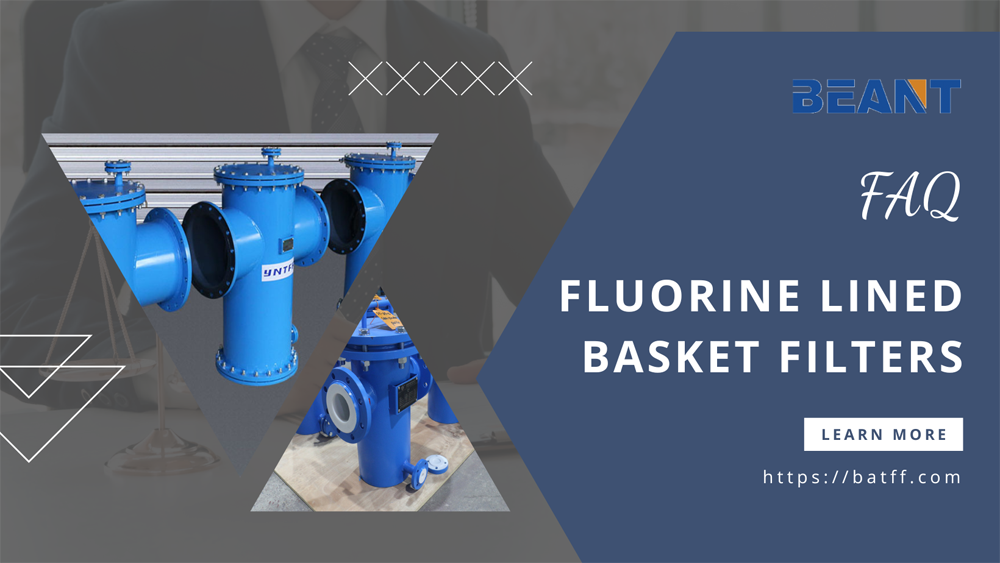
Fluorine lined basket filters are crucial components in many industrial processes, known for their exceptional chemical resistance and durability. These filters are designed to withstand harsh environments, making them ideal for industries that deal with corrosive substances. This FAQ article aims to provide a comprehensive understanding of fluorine lined basket filters, addressing common questions and offering insights into their applications, benefits, and maintenance.
A fluorine lined basket filter is a type of industrial filter that features a lining of fluoropolymer materials such as PTFE (Polytetrafluoroethylene) or FEP (Fluorinated Ethylene Propylene). These materials are renowned for their excellent chemical resistance, making the filters suitable for applications involving aggressive chemicals. The primary components of a fluorine lined basket filter include the basket (usually made of metal), the fluoropolymer lining, and a housing that encloses the basket. The lining protects the metal from corrosion, extending the filter's lifespan and maintaining its performance.
Fluorine lined basket filters offer several advantages over traditional filters.
Corrosion Resistance: The fluoropolymer lining provides outstanding resistance to a wide range of chemicals, including acids, bases, and solvents. This resistance prevents the filter from degrading, ensuring long-term reliability.
Chemical Compatibility: These filters can handle diverse chemical substances without reacting or degrading, making them versatile for various industrial applications.
Durability and Longevity: The robust construction and high-quality materials used in fluorine lined basket filters contribute to their durability, reducing the need for frequent replacements and lowering maintenance costs.
Industries such as chemical processing, petrochemical, and water treatment benefit significantly from these filters. In chemical processing, they protect equipment from corrosive substances, while in water treatment, they ensure the purity of processed water by removing contaminants without introducing chemical residues.
The operation of a fluorine lined basket filter is straightforward yet highly effective.
Filtration Mechanism: The fluid enters the filter housing and passes through the perforated basket lined with fluoropolymer. The basket traps solid particles and contaminants, allowing only clean fluid to exit through the outlet.
Flow Process: The fluid typically flows from the outside of the basket to the inside, ensuring that contaminants are captured on the exterior surface of the basket. This design facilitates easy cleaning and maintenance.
Operating Conditions: Fluorine lined basket filters are designed to operate under various conditions, including high pressure and temperature environments. They can be customized to handle specific flow rates and pressure requirements, ensuring optimal performance in different applications.
Fluorine lined basket filters are characterized by several key features that enhance their functionality and performance:
Design and Construction: These filters are designed to be robust, with a metal basket providing structural integrity and a fluoropolymer lining offering chemical resistance. The housing is typically made of stainless steel or other durable materials to withstand industrial conditions.
Performance Specifications: Fluorine lined basket filters are available in various sizes and capacities to meet different industrial needs. They are rated for specific flow rates, pressure drops, and temperature ranges, ensuring they can handle the demands of various applications.
Customization Options: Manufacturers offer customization options to tailor the filters to specific requirements. This includes selecting the appropriate fluoropolymer material, adjusting the basket's mesh size, and modifying the housing design to fit existing systems.
Proper installation is crucial to ensure the optimal performance of fluorine lined basket filters. Here is a step-by-step guide:
Preparation: Ensure the filter housing and piping system are clean and free from debris. Verify that the filter is compatible with the system's specifications.
Positioning: Place the filter in the desired location, ensuring it is easily accessible for maintenance. Secure the housing using appropriate mounting brackets or supports.
Connection: Connect the inlet and outlet pipes to the filter housing, ensuring a tight and leak-free fit. Use appropriate gaskets and seals to prevent leaks.
Alignment: Align the basket inside the housing, ensuring it is seated properly and securely.
Sealing: Close the housing and tighten all bolts and fasteners according to the manufacturer's specifications. Ensure all seals are properly engaged.
Verify that all connections are tight and leak-free before starting the system.
Ensure the filter is installed in a location where it can be easily accessed for maintenance and inspection.
Follow the manufacturer's guidelines for initial startup and operation.
Incorrect alignment of the basket, leading to improper filtration.
Over-tightening or under-tightening bolts, causing leaks or damage to the housing.
Neglecting to clean the system before installation, leading to contamination.
Regular maintenance is essential to ensure the longevity and efficiency of fluorine lined basket filters.
Inspection: Regularly inspect the filter for signs of wear, corrosion, or damage. Check the condition of the fluoropolymer lining and the basket.
Cleaning: Clean the basket periodically to remove accumulated debris and contaminants. Use appropriate cleaning agents that do not damage the fluoropolymer lining.
Replacement: Replace the basket or lining if signs of significant wear or damage are observed.
Shutdown: Shut down the system and relieve pressure before opening the filter housing.
Removal: Carefully remove the basket from the housing.
Cleaning: Use a soft brush or compressed air to remove loose particles. For stubborn contaminants, use a mild detergent or solvent compatible with the fluoropolymer lining.
Inspection: Inspect the basket and lining for signs of wear, corrosion, or damage. Check for any cracks, tears, or deformation.
Reinstallation: Reinstall the cleaned basket and close the housing securely.
Visible Damage: Cracks, tears, or significant wear on the fluoropolymer lining.
Decreased Performance: Reduced flow rate or increased pressure drop indicating clogging or damage.
Frequent Contaminant Breakthrough: If contaminants are bypassing the filter, it may be time to replace the basket.
Despite their durability, fluorine lined basket filters can encounter issues. Here are some common problems and solutions:
Leakage: Caused by loose connections, damaged seals, or improperly seated basket.
Reduced Flow Rate: Indicates clogging or blockage in the basket.
Chemical Attack: Occurs if the lining material is incompatible with the filtered substance.
Leakage: Tighten connections, replace damaged seals, and ensure the basket is seated correctly.
Reduced Flow Rate: Clean the basket and inspect for blockages. Replace if necessary.
Chemical Attack: Verify chemical compatibility before use and consult with the manufacturer for suitable lining materials.
Persistent leakage or performance issues.
Significant damage to the filter housing or basket.
Unusual chemical reactions or degradation of the lining.
Selecting the appropriate fluorine lined basket filter requires careful consideration of several factors:
Size and Capacity: Ensure the filter can handle the required flow rate and pressure.
Material Compatibility: Verify that the fluoropolymer lining is compatible with the chemicals being processed.
Application Requirements: Consider the specific needs of your application, such as temperature range, pressure conditions, and particulate size.
Consult with Experts: Engage with manufacturers or industry experts to determine the best filter for your needs.
Review Specifications: Thoroughly review the filter's specifications and compare them with your application requirements.
Consider Customization: Opt for custom filters if standard options do not meet your requirements.
Purchasing high-quality fluorine lined basket filters is crucial for ensuring reliability and performance.
Research and identify reputable manufacturers specializing in fluorine lined basket filters.
Consider suppliers with a proven track record and positive customer reviews.
Verify Credentials: Check the manufacturer's certifications and industry affiliations.
Request Samples: Ask for samples or case studies to assess the quality of the filters.
Understand Warranties: Review warranty terms and conditions to ensure adequate coverage and support.
Warranty Terms: Ensure the warranty covers material defects, workmanship, and performance issues.
Customer Support: Opt for suppliers that offer robust customer support, including technical assistance and after-sales service.
Fluorine lined basket filters are essential components in various industrial processes, offering superior chemical resistance and durability. Understanding their operation, benefits, and maintenance requirements is crucial for maximizing their performance and longevity. By addressing common questions and providing detailed insights, this FAQ article aims to equip users with the knowledge needed to make informed decisions and effectively utilize fluorine lined basket filters in their applications.
Feel free to leave your message on our board. If you're looking to inquire about prices or place an order, this is the right place! Let us know the details of your needs, and our team will get back to you with a personalized quote as quickly as possible. We're here to ensure your experience is seamless and satisfactory. Share your requirements or ask any questions you might have - we're eager to assist and look forward to doing business with you!
Name:Tim
Phone:+86-15716151880
Email:[email protected]
Company:BEANT
Address:No. 28, Luoshen Road, Luoshe Town, Huishan District, Wuxi City, Jiangsu Province
